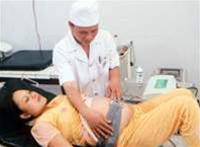Gestational Toxemia: A Serious Condition During Pregnancy
 |
|
Fetal monitoring machine at Kim Son Hospital – Ninh Binh (Photo: Huu Linh) |
If left untreated, gestational toxemia can lead to preeclampsia and eclampsia. Newborns of mothers with gestational toxemia often experience asphyxia during delivery.
Who is at Risk for Gestational Toxemia?
Pregnant women with a history of cardiovascular disease, high blood pressure, glomerulonephritis, obesity, multiple pregnancies, excessive amniotic fluid, or diabetes are at higher risk.
Symptoms of Gestational Toxemia
Edema: Swelling in both lower limbs, most commonly occurring in the third trimester. It can be detected by pressing a finger into the ankle, leaving a dimple. In severe cases, swelling may also affect the face and hands. Pregnant women experiencing edema due to compression can alleviate it by resting and elevating their legs; however, in gestational toxemia, edema does not subside with rest. Rapid weight gain of up to 500g per week may indicate fluid retention in the body.
A urine protein test showing levels greater than 0.3g/l is abnormal and requires monitoring for gestational toxemia.
High Blood Pressure: Pregnant women with gestational toxemia may experience a maximum blood pressure increase of approximately 30mmHg and a minimum increase of about 15mmHg in the later stages of pregnancy, or exhibit blood pressure readings above 140/90mmHg, necessitating monitoring and treatment for gestational toxemia.
Complications of Gestational Toxemia: If not effectively treated, gestational toxemia can lead to preeclampsia and eclampsia.
– Preeclampsia: Symptoms include dizziness, blurred vision, nausea, urine protein levels rising to 0.5g/l, worsening edema, and decreased urine output without seizures. If blood pressure exceeds 160/100mmHg without response to treatment, immediate delivery is necessary to prevent progression to eclampsia.
– Eclampsia: Typically occurs in the later stages of pregnancy, during labor, or after delivery. Mothers may experience seizures and coma, along with edema, high blood pressure, and protein in urine. It is more common in first-time mothers and usually occurs after the 30th week of pregnancy.
– Symptoms of Eclampsia: Characterized by severe convulsions, eye rolling, body stiffening, and rapid progression to twitching and jerking of the face and limbs, which may result in biting the tongue and foaming at the mouth, followed by pallor and cyanosis. If untreated, it can lead to heart failure, pulmonary edema, and cerebral hemorrhage, resulting in death.
– Pre-delivery Eclampsia: Seizures can lead to preterm labor, often resulting in fetal death. With proper treatment, mothers may still have normal vaginal delivery with a live infant.
– Eclampsia During Labor: Seizures can intensify uterine contractions, requiring immediate cesarean delivery if cervical dilation is slow.
– Post-delivery Eclampsia: Typically milder, these seizures occur a few hours after delivery. Mothers who give birth at healthcare stations and experience seizures must be closely monitored for each episode, with regular blood pressure checks and urine tests, and require prompt emergency care and transfer to a specialized maternity hospital.
– Prevention of Eclampsia: Effective monitoring and management of pregnancy are crucial. During pregnancy, it is important to maintain a balanced diet (carbohydrates, proteins, vitamins, trace elements, and iron and folic acid supplements). Regular prenatal check-ups are essential. If any swelling occurs, immediate medical evaluation is necessary to check blood pressure and urine. If healthcare providers detect edema, high blood pressure, or protein in urine, timely referral to a specialized maternity hospital is critical for safe treatment and delivery.
If a Mother Experiences Seizures, Follow These Steps:
Use a long splint or a wide stick to prevent the mother from biting her tongue during a seizure. In winter, keep the mother warm. Administer one of the sedatives such as morphine (0.01mg per ampoule); if morphine is unavailable, alternatives include barbiturates or seduxen, and quickly transfer the mother to a specialized maternity hospital.
Note: Mothers who experience seizures must be monitored for significant bleeding after delivery.
Untreated gestational toxemia can lead to preeclampsia and eclampsia. Pregnant women in their seventh month or at the 30th week with a blood pressure increase of 30mmHg or more and a minimum increase of 15mmHg from pre-pregnancy levels, or those with blood pressure above 140/90mmHg, must be monitored and treated promptly to prevent eclampsia.


















































